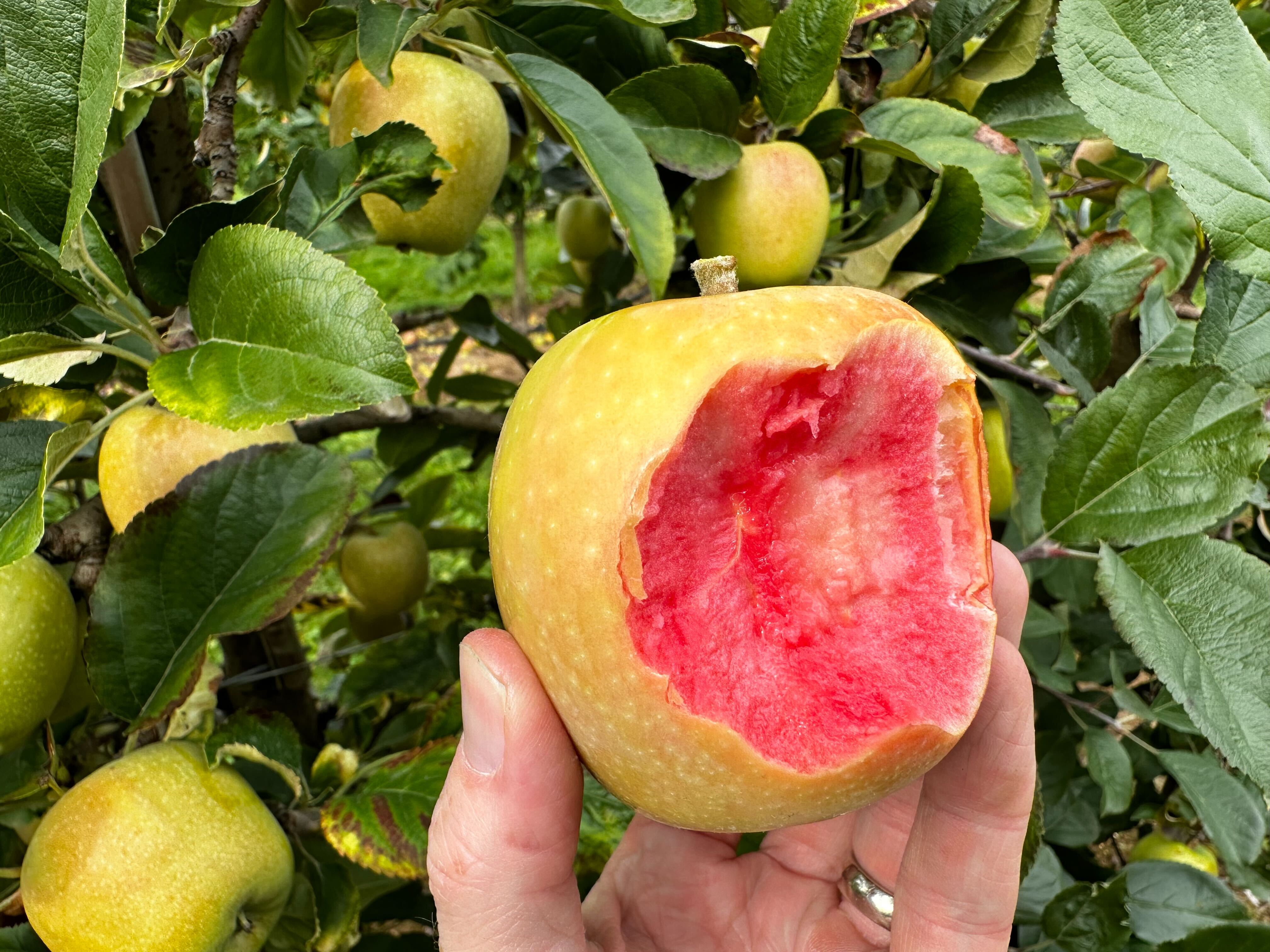
A freshly picked Mountain Rose apple at Kiyokawa Family Orchards in Parkdale Ore. October 9, 2024. Also known as Hidden Rose or Airlie Red Flesh, this native apple came from a chance seedling found in the 1960's in the unincorporated community of Airlie, Oregon.
Jeff Kastner / OPB
It was a cool October morning when I arrived at RainShine Family Farm. I’d been invited to attend a cider pressing under the premise that the apples they were using were unlike anything else. Smaller, with a green freckled exterior but inside held a surprise with a mysterious past.
“You’re not expecting it, but you bite in and it’s this bright, hot pink,” explained Christine Walter, the owner and head cider maker for Bauman’s Cider. She, along with a handful of other Northwest cider makers, had made the trek to unincorporated Kings Valley for the juice of this unique apple varietal.
“The apple itself, as an eating apple, it’s very acidic and very floral and you just get a huge ester bomb before it’s even fermented,” Walter said. “Some of the best cider makers in the region come for these apples and this juice.”
And the juice, much like the apple’s interior, is also a shocking rich magenta. The hard ciders made from it often keep that rosy hue, which has led to a burgeoning category of Rosé Ciders.
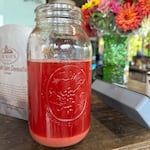
Juice from a cider pressing of Airlie Red Flesh apples at the RainShine Family Farm in Kings Valley, Ore. October 21, 2024.
Crystal Ligori / OPB
Emily Ritchie is the executive director at the Northwest Cider Association. She explained that in the last decade, they’ve seen a huge influx of red-fleshed apple ciders.
“As you taste cider made with red-flesh apples, you always get these similar and interesting characteristics,” she said. “It’s like if you taste a lot of Chardonnays or a lot of Pinot Noirs, there are similarities because the grape is the same.”
And this red-fleshed variety has been the foundation for the last two “Best of Show” winners of the NW Cider Cup.
Depending on who you ask, the apple can go by a few different names: Hidden Rose, Mountain Rose or Airlie Red Flesh. And it may be one of the only red-fleshed varieties native to Oregon.
“It’s a mysterious history,” said farmer Rachel Ashley. She and husband Elias Silvernail own RainShine Family Farm and the legend told to them starts with a couple who were walking on their property sometime in the 1950’s or ‘60’s and came across a wild apple tree.
“The story goes: the woman bit into it and her husband looked at her and said, ‘Audrey, the insides of that apple are the color of your lipstick!’”
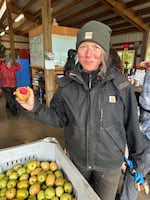
Farmer Rachel Ashley taking a bite out of a Airlie Red Flesh apple during a cider pressing at RainShine Family Farm, which she owns with husband Elias Silvernail. Kings Valley, Ore. October 21, 2024.
Crystal Ligori / OPB
Apples with a red or pink interior have been around for centuries. The aptly named Surprise apple was brought to the US from Europe in the early 1800’s and is thought to be a descendant from an ancient red-fleshed crabapple that grew wild across Western Asia.
The couple who found that tree were Lucky and Audrey Newell. Their property was in unincorporated Airlie, Oregon, just a few miles down the road from RainShine. But the Newells weren’t farmers–they were ranchers–and it seems like for them the apple tree was not much more than a unique anomaly.
It took another two decades for the apple to be re-discovered by Louis Kimzey, a former field manager at Thomas Paine Farms who seemingly stumbled across the apple in the same way as the Newells. Kimzey thought it was maybe another red-flesh variety called Pink Pearl, but took it to the nearby university for a second opinion.
“Oregon State University did whatever research they were going to do and came back and said, we don’t know what this is,” said Ashley. “This is a new variety – a chance seedling. It’s kind of a one-in-a-million thing.”
A one-in-a-million thing, because apples don’t reproduce in the same way most other fruits and vegetables do. If you plant an apple seed, you don’t know what you’re going to get.
“With apple genetics there’s such a mixed bag of variability and different turnouts that can happen,” said Kody Transue, bioscience research technician working in the orchards program at Oregon State University. “So because of that variability, that’s when the process of grafting comes in.
Transue explained that the only way to replicate the exact variety you want is by taking a cutting from the desired apple–called scion wood– and then grafting that with another apple tree which would act as the rootstock.

Airlie Red Flesh apples being harvested at RainShine Family Farm in Kings Valley, Ore. on October 21, 2024.
Crystal Ligori / OPB
So how then did this red-fleshed apple end up in rural Oregon? Transue said it could have been as simple as a bird or squirrel burying the seed there, or a passerby chucking their apple core into a field.
“And then out of all the genetic lottery, it turned out to be something worthwhile,” he said. “It’s pretty incredible.”
Transue’s mention of scion wood reminded me of a story Rachel Ashley had told me about the farmer they bought the land from.
“We had to sign a non-disclosure about some of the techniques he was using to grow the apples,” she said. “There was a lot of secrecy around things because he told us that there were people who came here and stole scion from his trees and brought it up to Washington and started orchards there.”
When they bought the farm, the apples were called Hidden Rose, a name trademarked by the previous owner. Nowadays, RainShine calls them Airlie Red Flesh, a nod to the apple’s Oregon history. But 130 miles away they go by another name: Mountain Rose. And they have been grown by Brady and John Jacobson of Mt. Hood Organic Farms for more than three decades.
Jacobson told me her husband probably connected with Louis Kimzey—the re-discoverer of the apple and the first person who likely propagated it—back in the 1980’s through the OSU Extension Service.
“This fellow reached out to John and said, ‘Do you want these trees? The rabbits are eating them all up,’” she said. “John took a couple of our guys in a truck and went down and they dug up maybe 20 trees and brought them here. We replanted them and John decided to call them Mountain Rose.”
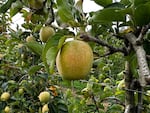
A Mountain Rose apple growing at the Kiyokawa Family Orchards in Parkdale, Ore. October 9, 2024. The green freckled skin holds a surprise of a deep red interior.
Jeff Kastner / OPB
The Jacobsons traded scion wood with others in the area including Randy Kiyokawa, a third-generation orchardist who has Kiyokawa Family Orchards. So if all this scion wood was being shared, was there any validity to the claim of scion wood being stolen from the Airlie orchard? Jacobson said yes.
“I wouldn’t doubt that people took scion wood from his orchard,” she explained. “It’s hard to find something that really has value in agriculture. We’ve been growing things for long enough to know that once somebody has something that’s worth money, worth more than something else, everybody will try and start growing it. So people will get it by hook or by crook.”
And these apples can be worth a lot of money. Rachel Ashley explained when they first took over the orchard, they were selling the Airlie Red Flesh to a high end distributor.
“They all had to be a certain size, no blemishes, totally perfect and we lost money,” she said. “And food doesn’t have to look perfect to be nutritious and delicious.”
Which is why the cider industry she said was a blessing for the farm.
“They don’t mind the blemishes and the scabs and the imperfection, they still value it for the juice, for the flavor, for the terroir,” she said. “And the juice is beautiful. It’s a real local gem.”
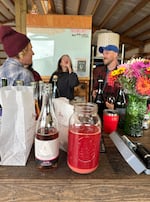
A jug of fresh Airlie Red Flesh apple juice sits next to an Alpenfire Cider made from the same apple variety, while cider makers Christine Walter (L) and Levi Danielson (R) sample ciders on the RainShine Family Farm. October 21, 2024.
Crystal Ligori / OPB


